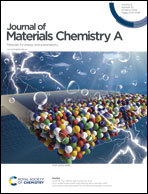Regulating oxygen functionalities of cellulose-derived hard carbon toward superior sodium storage†
Abstract
Cellulose is an important precursor for hard carbon for use in sodium-ion battery anodes, owing to its low cost and abundant resource. However, how to modulate the structure of cellulose-based carbon materials which possesses increased low-voltage plateau Na-storage capacity is still a great challenge. Herein, we select a kind of cellulose with high polymerization degree and low crystallinity as the carbon source. Pre-oxidation was employed to cleave the cellulose glycosidic bond and induce cross-linking of the molecular chains. The oxidative crosslinking process of cellulose produces more C![[double bond, length as m-dash]](https://www.rsc.org/images/entities/char_e001.gif) O and retains more C–O. During pyrolysis, narrower and longer graphite microcrystalline structures are generated, resulting in the formation of larger closed pores. The hard carbon samples prepared from the precursor with the optimal oxygen functionality content exhibit the lowest specific surface area (8.7 m2 g−1) and the highest closed pore volume. After optimization, there is a substantial increase in the plateau capacity, and excellent sodium storage performance is achieved. The reversible capacity achieves an impressive value of 426.8 mA h g−1, with the plateau capacity accounting for 72.1% and reaching 307.5 mA h g−1. This research provides valuable insights into the rational design of hard carbon anodes with a substantial plateau capacity in the field of sodium-ion batteries.
O and retains more C–O. During pyrolysis, narrower and longer graphite microcrystalline structures are generated, resulting in the formation of larger closed pores. The hard carbon samples prepared from the precursor with the optimal oxygen functionality content exhibit the lowest specific surface area (8.7 m2 g−1) and the highest closed pore volume. After optimization, there is a substantial increase in the plateau capacity, and excellent sodium storage performance is achieved. The reversible capacity achieves an impressive value of 426.8 mA h g−1, with the plateau capacity accounting for 72.1% and reaching 307.5 mA h g−1. This research provides valuable insights into the rational design of hard carbon anodes with a substantial plateau capacity in the field of sodium-ion batteries.



 Please wait while we load your content...
Please wait while we load your content...